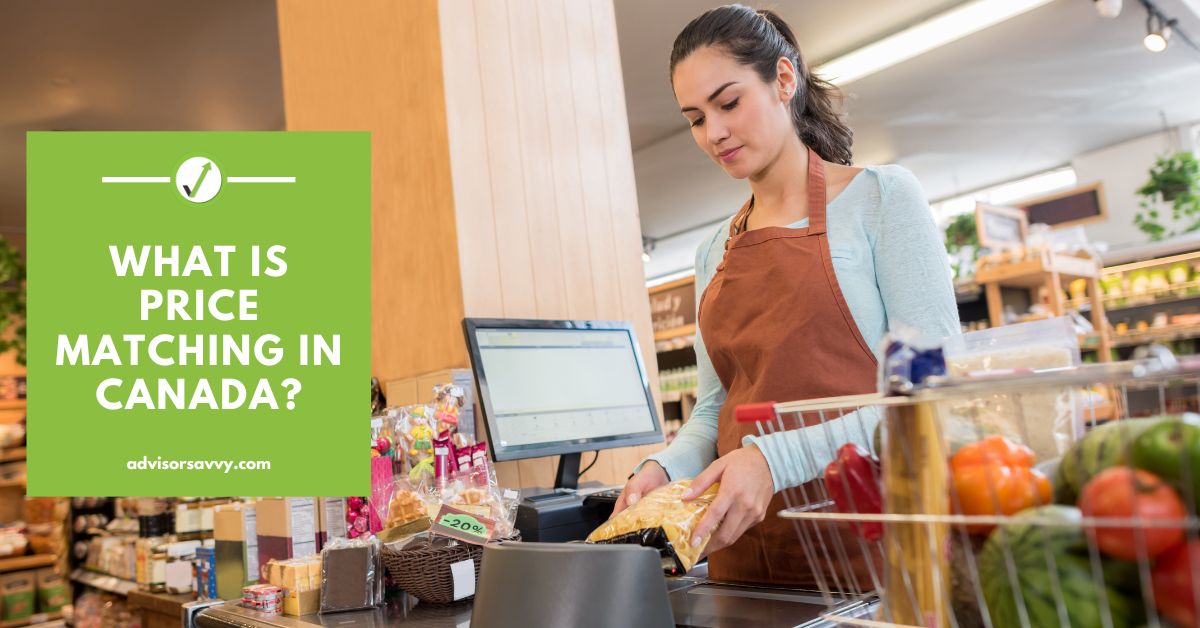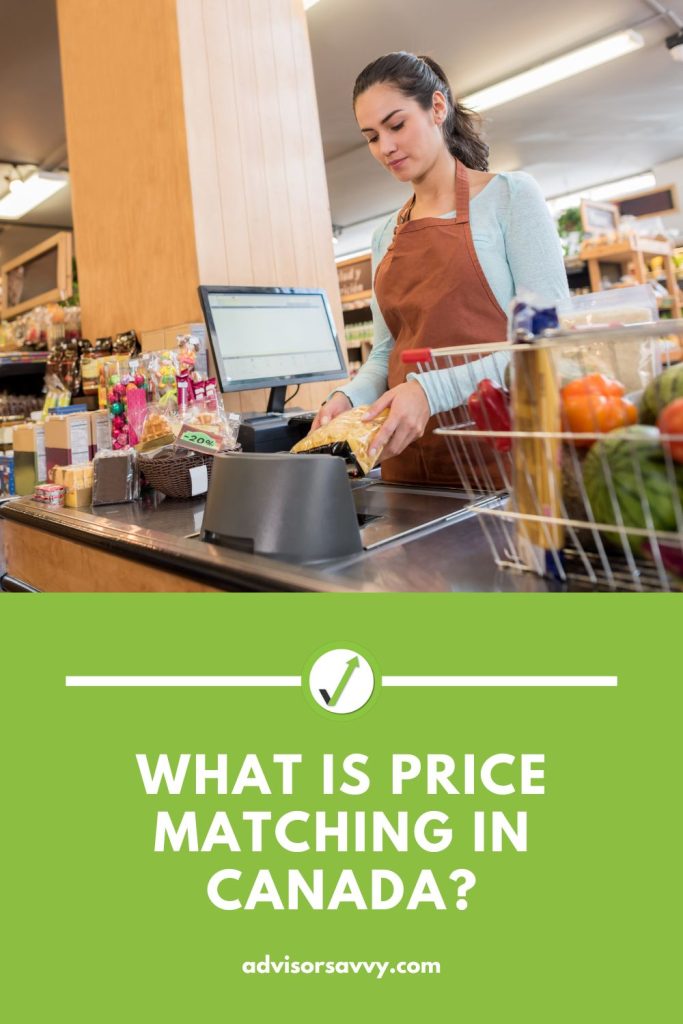
Canadians have been hard hit by inflation and rising grocery costs. Deal hunting, couponing and price matching can help to save money. By seeking out deals, many Canadians can save up to $50 or more per grocery trip. Although, this is a generous estimate that only seasoned deal hunters reach. But, with dedication and time, you can become a seasoned deal hunter. If you find yourself asking, what is price matching? It may be the shopping and spending relief you’ve been looking for. Keep reading to learn more about price matching in Canada and how it works!
Related Reading: Surviving Inflation: Top 7 Tips

Table of contents
- What is price matching?
- How does the price match work?
- What is a price match guarantee?
- What are the advantages of price matching?
- What are the disadvantages of price matching?
- How do I request a price match?
- Can I price match after purchase?
- Popular Vendors Who Price Match in Canada
- Price Matching in Canada
What is price matching?
Price matching occurs when a retailer honours or beats the advertised price of another store. To access price matching, the specific supplier has to offer it. Generally, the price you are trying to match must be an advertised price from a major retailer. The product also must be identical in every way. This policy is designed to attract customers by ensuring they get the best possible price. In turn, customers do not have to shop around at multiple stores.
Price matching policies can vary from one store to another. Customers should familiarize themselves with their local store’s specific price-matching policy before getting started. This is all a part of the learning curve and you will get better at it with time. Policies can change over time too, so it’s a good idea to keep a lookout for the latest information.

Get the lowest mortgage rates and mortgage rate holds in Canada
Related Reading: Grocery Rebate in Canada
How does the price match work?
Price matching is a retail policy. It allows customers to secure the best possible price for a product. Through price matching policies, stores either match or beat the prices offered by competitors. Retailers are motivated to offer price matching to their customers because they want your business, not for you to go to the cheaper option. Taking advantage of price matching can be simple, as follows:
- Customers identify an identical product at a lower price from a competitor.
- They provide proof of the lower price to the retailer they prefer to shop with.
- Customers must present a valid printed or digital copy of the advertised price.
- If the item falls in the price matching policy criteria, that retailer will honour or beat the price, depending on their specific policy.
- The cashier will verify to ensure the product matches the criteria.
- If approved, the price is adjusted to match or beat the competitor’s price. The retailer gets your business and the customer gets the lowest price.
The adjustment normally occurs at the time of purchase. However, some retailers offer a refund for a prior purchase. Consumers must understand the specific policies and procedures of the retailer in question. Many price matching variations exist among different stores.
Related Reading: Best Retail ETFs in Canada
What is a price match guarantee?
A price match guarantee is a retail policy. It assures customers that the store will match or beat the prices offered by competitors. Although, this is reserved for identical products. This guarantee is designed to give consumers confidence that they are getting the best deal. In essence, a price match guarantee is an advertisement from a retailer to attract customers to their store because they will always get the lowest price.
When a customer finds a lower price for a specific product at a competing store, a retailer with a price match guarantee will adjust the price of the product. This is to match or beat the competitor’s price. The guarantee may have specific conditions. Each retailer has different requirements. Most commonly, they require proof of the competitor’s lower price. They review the advertisement to ensure identical brand, weight, and size. Price match guarantees are a common strategy employed by retailers to attract customers. It also helps foster loyalty by assuring them of competitive pricing.
What are the advantages of price matching?
Price matching offers several advantages for both retailers and consumers:
Customer Satisfaction and Loyalty
Price matching enhances customer satisfaction and loyalty. It ensures that customers get the best possible price. Without requiring them to physically shop around. This contributes to a positive shopping experience. It further builds trust between the customer and the retailer, which further increases a customer’s loyalty to a retailer.
Competitive Edge
Retailers use price matching as a competitive strategy. It positions the retailer as offering such competitive prices, they can match anyone else’s. This further helps retain existing customers while attracting new ones.
Increased Sales
Retailers may see increased sales. This is because customers feel more confident in making purchases from them since they know they will always get the lowest price. This is especially true for customers who are only drawn to a store because of its price matching policy and generally low costs.
Reduced Customer Effort
Price matching reduces the effort customers need to invest in finding the best deals. Instead of travelling to multiple stores or spending ample time searching online, customers can rely on a store’s price-matching policy to ensure they are getting a competitive price. Sure, the customer still has to do some research on prices, but at least they can get the lowest price by visiting one store.
Related Reading: What is the Best Bank in Canada?
What are the disadvantages of price matching?
While price matching offers various advantages, there are also potential disadvantages:
Profit Margins
Price matching can squeeze profit margins for retailers. This becomes an issue if they match or beat prices for products they have not purchased cheaply. This can impact the overall profitability of the business. Small businesses may have difficulty keeping up, especially.
Abuse of Policy
Some customers may attempt to abuse the price-matching policy. They can provide inaccurate or fraudulent information, and exploit loopholes. This would result in financial losses for the retailer, which can affect their ability to offer price matching liberally. They may have to adjust to more restrictive policies. In turn, this affects other customers who were using the policies fairly.
Operational Challenges
Implementing a price matching policy can pose operational challenges. There is a need for staff training on the policy’s terms and conditions. Creating efficient systems for verification, and processes to handle adjustments seamlessly. This takes time and slows down the shopping experience for other customers. In addition, many stores are cutting out cashiers and replacing them with self-checkouts. However, personnel is needed to execute price matching, which is an additional operational challenge.
Consumer Expectations and Communication Issues
Price matching can create high consumer expectations. Failure to consistently meet these expectations may lead to customer dissatisfaction. If policies are not written clearly and communicated well to customers, they may become frustrated at the promise of lower prices not being fulfilled. There could be exclusions that a customer was not aware of. This could lead to them shopping elsewhere.
Related Reading: Banking vs Financial Services: What’s the Difference?
How do I request a price match?
The process of price matching generally involves several steps. They can vary slightly depending on the specific policies of the retailer. Here’s a general process of how to request a price match:
1. Identify the Identical Product
The product you want to purchase must be identical to the one offered by a competitor. This includes brand, model, size, colour, specifications, and any other relevant features.
2. Check Eligibility Conditions
Review the retailer’s price matching policy. Ensure you understand the conditions and requirements to fulfill a price match before going to the store.
3. Provide Proof of Competitor’s Price
To request a price match, you usually need to provide proof of the lower price. This could be a current advertisement either printed or digital. Make sure the proof includes all relevant details, such as the product name, price, and the date of the offer.
4. Communicate with the Salesperson or Cashier
Present the proof of the competitor’s lower price and request a price match. Retailers will have different steps for verification. However, communicating that you would like to price match connects you to their process. From there, provide all the necessary details they require to fulfill a price match.
5. Verification
The retailer will typically verify the competitor’s price. They will also ensure that the product is identical. This will require a detailed review of the presented advertisement.
6. Adjustment or Discount
If the price match is approved, the retailer will adjust the price of the product. This adjustment is most often applied at the time of purchase. However, sometimes refunds can be issued for already purchased products instead.
7. Complete the Purchase
Once the price match is added to your purchase, you can complete the purchase at the adjusted price.
The specific details of the price-matching process vary between retailers. It is recommended you familiarize yourself with the policies of the stores you frequently shop at.
Can I price match after purchase?
Many retailers do offer post-purchase price matching. This would require proof of purchase and proof of the lower advertised price. Normally this must be within a limited timeframe from your original purchase. Each store has different policies on post-purchase price matching. Inquire with the store of the original purchase if you find a better deal somewhere else.
Popular Vendors Who Price Match in Canada
Several retailers in Canada have been known to offer price matching. Here are some popular vendors in Canada that offer price matching to their customers:
- No Frills. No Frills is a large Canadian discount grocery store. They offer a price match.
- Best Buy. Best Buy offers a low-price guarantee. This will match the price of both local and online competitors. They will even offer this after purchase if you find a better deal within 30 days.
- Walmart. Walmart has a price-matching policy. Their policy has some notable exclusions.
- Staples. Staples offers a price match. They match the prices of competitors for identical products. They will match after purchase as well, within a limited time frame.
- Home Depot. Home Depot has a Price Match Guarantee. They promise to match the prices of competitors.
- Sport Chek. Sport Chek has a price-matching policy. They match the prices of other retailers.
- Freshco. FreshCo offers the Lowest Price Guarantee. With this, they will charge you $0.01 less than a competitor’s advertised price.
Price Matching in Canada
Price matching in Canada is a retail strategy that benefits both consumers and retailers. It ensures competitive pricing and customer satisfaction. Many popular vendors in Canada offer price-matching policies. This allows customers to secure the best possible prices for identical products and keep costs low. Clear communication and transparent policies are needed for price matching. Always review the policy of the store you intend to price match at. Here is a large list of stores that offer price matching.
Read More: Buy Now, Pay Later: What You Need to Know
